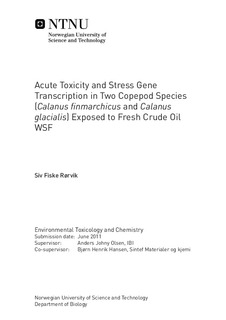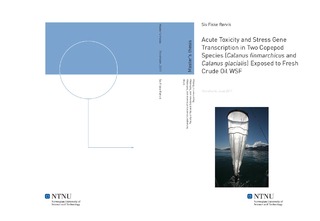| dc.contributor.advisor | Olsen, Anders Johny | nb_NO |
| dc.contributor.advisor | Hansen, Bjørn Henrik | nb_NO |
| dc.contributor.author | Rørvik, Siv Fiske | nb_NO |
| dc.date.accessioned | 2014-12-19T13:11:59Z | |
| dc.date.available | 2014-12-19T13:11:59Z | |
| dc.date.created | 2011-08-24 | nb_NO |
| dc.date.issued | 2011 | nb_NO |
| dc.identifier | 436567 | nb_NO |
| dc.identifier | ntnudaim:6616 | nb_NO |
| dc.identifier.uri | http://hdl.handle.net/11250/244843 | |
| dc.description.abstract | Increasing oil activities from the gas and oil industry may constitute a hazard towards the marine environment due to potential risks for accidents, such as oil spills. This study examine acute eects on mortality (LC50) and stress gene expressions in two closely related copepod species, Calanus finmarchicus(temperate-boreal species) and Calanus glacialis (Arctic species), adapted to dierent temperatures 10 C and 2 C, respectively. The copepod species were exposed to water soluble hydrocarbon fractions (WSFs)of fresh crude oil. In addition, an experiment was conducted in order to investigate if lipid rich specimen survived a longer exposure of WSFs than lipid poor specimen. The results from the acute toxicity tests indicated that the Arctic species is more tolerated to WSF exposure than the temperate species. Gene expression analysis revealed that both species induced glutathione S-transferase (GST) mRNA levels in a concentration- and time related manner. Calanus glacialis showed a greater and faster induction of the GST transcription compared to Calanus nmarchicus. The results of gene expression analysis of superoxide dismutase (SOD), cytochrome 330A1 (CYP330A1) and gamma-glutmylcystein synthase (gGCS) did not show any concentration- and time related trends following WSF exposure. Biometric measurements of the specimen, and analyzing by a linear multi variable regression model showed that neither of the variables, including the lipid content, explained the dierences in surviving a WSFs exposure. The study support the use of the cultured Calanus species as a model species when testing for acute eects in themarine environment. | nb_NO |
| dc.language | eng | nb_NO |
| dc.publisher | Institutt for biologi | nb_NO |
| dc.subject | ntnudaim:6616 | no_NO |
| dc.subject | MSENVITOX Environmental Toxicology and Chemistry | no_NO |
| dc.subject | Environmental Toxicology | no_NO |
| dc.title | Acute Toxicity and Stress Gene Transcription in Two Copepod Species (Calanus finmarchicus and Calanus glacialis) Exposed to Fresh Crude Oil WSF | nb_NO |
| dc.type | Master thesis | nb_NO |
| dc.source.pagenumber | 95 | nb_NO |
| dc.contributor.department | Norges teknisk-naturvitenskapelige universitet, Fakultet for naturvitenskap og teknologi, Institutt for biologi | nb_NO |

